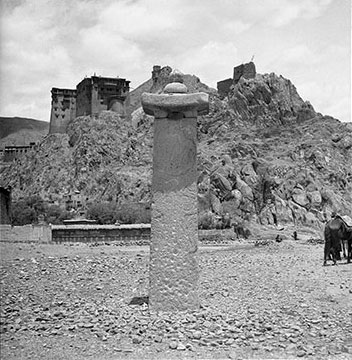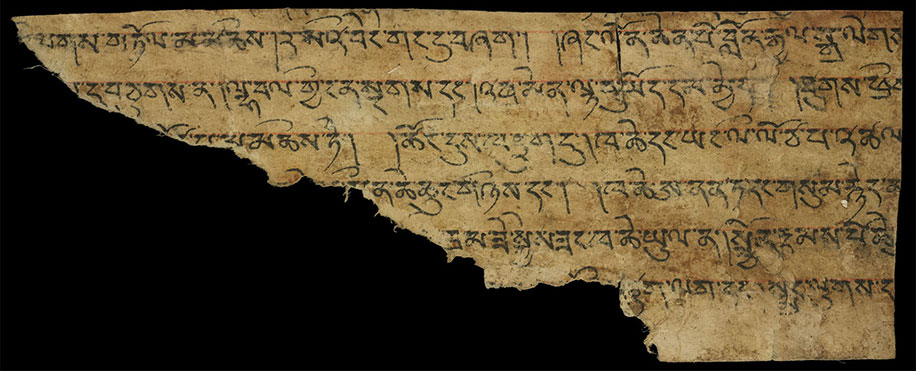Khrims: changes in the Tibetan concept of law
The Tibetan concept of khrims can generally be rendered as ‘law’. Examining early sources, however, suggests a subtle shift in the ambit and significance of this term towards the end of the imperial period. This was a time during which new ideologies about Tibetan history, kingship, and statehood were being worked out and the concept of khrims came to play a new, and prominent, role within them. In this post I trace these changes and consider their historical context.
The earliest, datable, reference to khrims (grims) is found in the Old Tibetan Annals for 655–56 (below): the chief minister made a bka’ grims kyi yi ge, a legal code, the year after the emperor’s rtsis mgo, administrative plan.

© Bibliotèque Nationale de France, PT 1288

© Pitt Rivers Museum, Oxford
Among the documents found at Dunhuang there are copies of legal codes, which specify compensation for homicide, injuries, and theft. There are also records of individual cases, which refer to several sorts of khrims, including rules for guarantors (gnya’ khrims) and other procedural matters.1 There are some references to bka’ grims, indicating (Tibetan) law, in general, but for the most part the khrims seem to have been specific laws or legal codes, which were referred to as guidance in legal cases.
In other imperial sources, emperors are credited with the establishment and maintenance of peace, order, and good customs. The concepts of chos (lugs) bzang (good customs and practices) and gtsug lag (administrative order) are found in the inscription on Tri Song Detsen’s tomb, for example, in the Sino-Tibetan treaty of 822, scattered throughout the Prayers of Dega Yutsel, written at around the same time, and in the Old Tibetan Chronicle (from the 840s).
In these, more ideological, accounts references to law are surprisingly sparse. The Chronicle has a single reference, attributing the making of a gtsug lag bka’ khrims ched po (a great legal and administrative edict) to Songtsen Gampo. During the last decades of the empire, then, the rulers were being credited with the establishment of gtsug lag (good order) and chos bzang (good practices), but law-making was not fundamental to these achievements.
Later texts
It is not until some time later that historical accounts begin to attribute the establishment of good order to the reception of Buddhism. The Scripture from the Sky (Dharma from Heaven), which van Schaik dates to some time after the turmoil of the mid-ninth century,2 looks back to the rulers of an earlier era.

© British Library, IOL 370
They are said to have received bstan pa (or dar ma, scriptures), on the basis of which they established chos gtsug lag (good order and customs). The result was a domain characterized by peace and moral behaviour. The text refers to law (khrims) as an activity of a protective king (myi mgon), but it is just one of the characteristics of a good kingdom, alongside the path of truth, the discipline of the ten virtues, and the teachings of wise forebears. Buddhist ideas are now shaping the account of Tibetan kingship, but law still only plays a minor role within it.
The dBa’ bzhed
The Chronicle of the Ba clan marks a further shift and a new emphasis on law. The early sections of the account concern the activities of Songtsen Gampo, after his ancestors have received scriptures from the sky. The king sends Tonmi Sambota to India to learn writing, so as to be able to understand these documents, and the minister also brings back the text of the ten virtues. After he has created a Tibetan script, Songtsen Gampo makes laws (bka’ khrims), on the basis of those ten virtues. These are announced to the people, along with a rtsis mgo (administrative plan) and the chos lugs bzang po (rules for good behaviour), and he gives strict instructions about the observation of the laws.

© British Library, Or 8210/S.9498A
The references to the rtsis mgo and chos lugs recall the language of the Annals and the tomb inscription. However, in this text they are firmly associated with the bka’ khrims, laws, which are themselves based on the ten (Buddhist) virtues. In this account, then, the making of the laws has become a foundational act for the great imperial order. The khrims are said to concern compensation and punishment for homicide, injury, stealing, and sexual misconduct, but they are also associated with rules for the conduct of the subjects (chos lugs bzang po). Laws are no longer simply judicial instruments, then; they also guide the people towards good behaviour in accordance with the ten virtues.
In a later section of the Chronicle, concerning the reign of Ralpachan, it is said that the chos khrims were ‘re-tied’, like a silken knot, indicating that practices of Buddhism were being re-established. This suggests a new type of khrims, relating specifically to religious practice. This sets the scene for later texts, which refer to both rgyal khrims and chos khrims, royal and religious laws.
By the time of the dBa’ bzhed, then, the concept of khrims has come to replace the gtsug lag of the earlier texts as the foundation of imperial order. The term gtsug lag is now being associated with religious establishments (gtsug lag khang), while chos is more closely associated with religious practices.3 The concept of khrims does not change so markedly, but it does widen from a sense of imperial edicts and judicial instruments to include more general rules for moral conduct and religious discipline. It has also become central to the account of the religious roots of Tibetan civilization. From this point onwards the historical narratives (including the bKa’ chems ka khol ma and the many others that follow it) almost always credit Songtsen Gampo with the creation of law based on the ten virtues.
The dating of the dBa’ bzhed is uncertain: the Dunhuang fragments relate to a different part of the narrative, so the early section on Songtsen Gampo could date from any time up to the twelfth century. However, it does seem to mark a shift between the ideas of the Old Tibetan Chronicle and those of a later tradition of historical writing. It is in the period of imperial disintegration and its aftermath, then, that we find the emergence of new ideas about law, which would become central to later Tibetan ideologies of law and government.
References
Dotson, Brandon. 2015. Introducing Early Tibetan Law: Codes and Cases. In D. Schuh (ed.) Secular Law and Order in the Tibetan Highland. Andiast: IITBS.
Pasang Wangdu and Hildegard Diemberger. 2000. dBa’ bzhed: The Royal Narrative Concerning the Bringing of the Buddha’s Doctrine to Tibet. Vienna: Verlag der Österreichischen Akademie der Wissenschaften.
van Schaik, Sam. 2013. The Naming of the Tibetan Religion: Bon and Chos in the Tibetan Imperial Period, Journal of the International Association of Bon Research 1: 227–57.
van Schaik, Sam and Kazushi Iwao. 2008. Two fragments of the Testament of Ba from Dunhuang, Journal of the American Oriental Society 128: 477–87.
Texts
The Old Tibetan Annals (PT 1288)
Prayers of Dega Yutsel (PT 16/IOL 751)
The Old Tibetan Chronicle (PT 1287)
The Scripture from the Sky (Dharma from Heaven) (IOL 370)
1 These cases, which concern theft, land use and ownership, assault, injury, and ownership of women, are discussed by Dotson (2015).
2 earlytibet.com/2010/09/24/dharma-from-the-sky-iii/
3 As van Schaik (2013: 237–40) points out, in earlier texts it has the wider meaning of (prescribed) conduct or customs.




